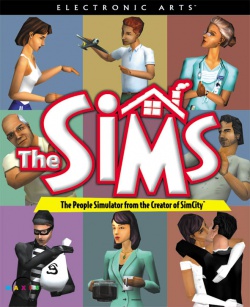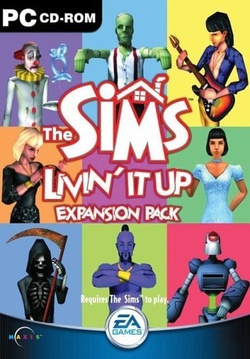GameSpot Preview Wraps Up

GameSpot posted the final installment of their 3-part Livin' Large preview. Check out the great Will Wright interview!
Go To Gamespot's Preview, or click read more below to read the third part of the GameSpot preview, a Q&A with Will Wright!
For the past two weeks, we've been running in-depth previews on the upcoming add-on for The Sims, Maxis' extremely successful real-life simulator. Called Livin' Large, this expansion pack adds a number of enhancements to the original game, including three new interior decor styles, 50 new jobs, ten additional neighborhoods, and more than 120 new simulation items for your Sims to buy and interact with. Our previews have covered most, if not all, of the new features to be found in Livin' Large. As an encore, we sat down with Maxis cofounder Will Wright, the man largely responsible for The Sims, to talk about his role in the design of Livin' Large, his inspiration for The Sims' unique brand of gameplay, and the future of Maxis.
GameSpot: When was the first time you came up with the idea for The Sims? Was it inspired by anything?
Will Wright: Well, when I first started thinking about this game I was envisioning a game that was more focused on the architectural side of things. This was around 1993, before I worked on SimCity 2000. I was very impressed with a particular book, A Pattern Language by Christopher Alexander. Later, as we got the behavioral model for the people running, things began to change. The Sims were so fun to mess with and control that the game became more focused on their lives.
GS: The premise behind a game like The Sims is relatively simple. Why do you think nobody has endeavored to make a "life simulator" before?
WW: Because it's hard? Some of the simplest-looking things in The Sims (like cooking a meal) are really very complex when you consider how many different situations we have to deal with. There are an infinite variety of kitchen configurations the player can design and a large number of social contexts [that] can occur - the whole family attracted to a group meal at the same time, sitting together and then conversing over dinner, etc. And this is maybe just 2 percent of the total behavioral code. This is what is known in the computer industry as a "defensible" technology (supposedly it will be hard for others to re-create this because it was so hard for us to create it).
GS: What else was hard in designing The Sims? What was your largest hurdle?
WW: Modeling the human behavior was probably the hardest part. Of course there are very restrictive limits to what we can do with today's technology. Today I would say we have what might be called a "human flocking" level of behavior. We can simulate fairly convincing behavior at a distance but not face to face yet.
GS: The ability to interact with other Sims online was on top of a lot of gamers' wish lists. Why didn't you add a true multiplayer component to The Sims?
WW: Gameplay in The Sims is very focused on the limited control you have over the people. They aren't quite avatars nor are they NPCs (nonplayer characters). So for this reason a multiplayer feature isn't something we can just "tack on" at the end and still have the game play well. Basically we either wanted to do it very well or not at all.
In fact we're working on a multiplayer version right now. In some ways it's very much like The Sims 1.0; in other ways it's really quite different.
GS: How is this multiplayer version like The Sims, and how is it different?
WW: Well, I can't really talk about that right now. We're still really early in development. Our PR director would kill me if I started talking about it now.
GS: People were also expecting 3D models and actual spoken dialogue to be included in The Sims. Why were these left out?
WW: The objects and people in The Sims both start as 3D models. The objects are then prerendered into z-buffered sprites for the graphics engine while the people remain as real-time 3D models. If you mean why isn't the game in full 3D, that is primarily a question of balance. There is a very tricky balance to be struck in this case between minimum platform, object detail, interface complexity (navigation), and ease of editing.
There was also one other major reason why we chose to stick with the isometric (actually, to be precise it's isogonic) perspective and that's for reasons of abstraction. The most important design requirement of The Sims was to simulate reasonably plausible human behavior at some level. The key phrase here is "at some level." By literally stepping back a bit from the people (as you might see them from a second-floor window), we managed to avoid many of the traditional brick walls of AI. By limiting how close the camera can get to them, we can avoid facial expressions and many other hard animation issues. By abstracting their language into gestures, icons, and emotional voice intonation, we keep the conversations real by inviting the player to fill in the details of the dialogue (this also made a simultaneous release in 14 languages possible).
The idea of engineering abstraction to fully leverage the player's imagination is very appealing to me. In some sense The Sims is actually running on two computers simultaneously - the PC you play it on and the one in your head as you unconsciously fill in the details of what you see. I would recommend Scott McCloud's book Understanding Comics for those interested in this stuff.
GS: With genies and alien abductions, Livin' Large seems a bit wackier than The Sims. Why did you opt to move away from realism in the expansion pack?
WW: One of the main reasons The Sims is so novel is because it's so mundane. I mean here's a best-selling game where instead of conquering armies or saving the world you spend your time cleaning the toilet and taking out the trash. If the original game had a more wacky style to it (like Livin' Large), then much of this novel humor would have been lost. Also, the original game was very neutral in presentation, which made it a good common starting point for the players to take it in different directions (comedy, romance, tragedy, etc.) in a storytelling sense.
Now that players have had the opportunity to spend time with the neutral, mundane version of The Sims, there is much less risk in us going into odd directions with expansions. Some of the more unusual objects in Livin' Large (chemistry set, tragic clown) will hopefully spark the creativity of players to take the game into weird, twisted directions that we can only guess at.
GS: Some of the skins in Livin' Large were actually created by fans of the game and selected by your designers for inclusion in the game. How important a role do user feedback and participation play in your game design?
WW: Feedback (and participation) from the players and fans has become of tremendous importance to what we do. When we brainstorm new projects now, we don't think in terms of how to make a really cool game but more about how can we create a cool new community with a game.
About eight months before we released The Sims, we started a mail-list group with about 30 webmasters from SimCity fan sites. We asked for their feedback, sent them progress updates, and sent them customization tools on an almost weekly basis while the game was in development. They not only had a major impact on the final design, but they also created the first wave of fan sites for The Sims. Because of the early tools we gave them, they also had a large amount of user-created content up on the Web the day the game shipped.
GS: Obviously, your designers and producers are a big part of a game's overall design. How many of the new items and features specifically in Livin' Large did you personally create or decide on?
WW: I don't remember, but it was actually very few (the tragic clown was my pet object). Our Sims team is run quite organically, which means that design contributions can (and do) come from anyone on the team. My codesigner Chris Trottier has taken much more design responsibility for Livin' Large than I have. I've been spending more time on multiplayer work. Now that I think about it, there are probably at least five members on the Livin' Large team that had more of a design impact than I did. From my point of view, it's really nice to have a team that you trust to that level.
GS: Even after the groundswell of support received by SimCity 3000, did you ever expect The Sims to be this popular?
WW: I figured The Sims would either be huge or a total bomb. I couldn't envision it as a moderate success. Realistically I gave it about a 50/50 chance either way.
GS: You've ported older Maxis games to consoles in the past. Will The Sims or Livin' Large make their way onto any of the next-gen consoles?
WW: It's something that we are discussing. But nothing is being coded at the moment. I've done a little bit of work on a Palm OS application that is in the spirit of The Sims' home design game.
GS: A lot of people have described your next project, SimsVille, as a cross between The Sims and SimCity. Is this accurate?
WW: First of all, contrary to popular opinion, SimsVille is not my project. I really had nothing to do with it. It grew out of conceptual work from the SimCity team. The idea is still evolving, but I do think it will end up falling between SimCity and The Sims. In addition to the core SimCity team that started the project, my two codesigners on The Sims (Claire Curtain and Roxy Wolosenko), who never get enough credit, have moved to design roles on that project.
GS: Since it's not your project, how much control do you have over its design, and how much control do you want over its design?
WW: I provide input when the design team asks for my advice, and that's just how I like it.
GS: What's after SimsVille? Will you make a new SimCity or The Sims game, or do you want to create a new property altogether?
WW: Of course as a designer I like working on fresh new things. I don't really get very inspired by working on sequels. The Sims Online is a rather special case though. It's quite different from The Sims in some very neat ways, and I've never designed a multiplayer game before. I've been waiting for them to become more mainstream, and now the time seems right.
I also have another completely different project in the very early stages right now (about where The Sims was in '93). The word "ambitious" doesn't even begin to do it justice.
GS: And when is The Sims Online scheduled for release?
WW: I can't tell you. It certainly won't take as long as the first version of the game.















